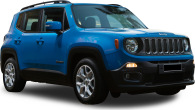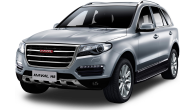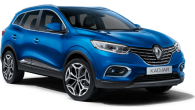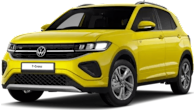The Ford Everest is one of the better examples of a ute-based 4WD wagon. It has consistently done a good job of satisfying driver desires for a family-friendly SUV with car-like ride and handling, while also being a very effective off-roader.
The addition of a 2.0-litre twin-turbo diesel engine to the mix – as standard on 2019 Titanium models – has drawn plenty of criticism, but that's mostly been a knee-jerk response from people who haven't yet driven the new Everest with that powerplant in it.
We took a Titanium on one of NSW's tougher 4WD bush trips – even considered a decent challenge for modified 4WDs – to see how the showroom-standard Everest would fare on the rough stuff.
Did we break anything on the Everest? Did we get stuck and have to be recovered by a modified 4WD? Did we even reach our destination? Read on to find out.
Ford Everest 2019: Titanium (4Wd 7 Seat)
| Engine Type | Diesel Twin Turbo 4, 2.0L |
|---|---|
| Fuel Type | Diesel |
| Fuel Efficiency | 7.1L/100km (combined) |
| Seating | 7 |
| Price From | $38,610 - $45,430 |
| Safety Rating |
|
Does it represent good value for the price? What features does it come with?
The 2019 Titanium, in showrooms now, tops the three-model Everest range, above the entry-level Ambiente and mid-spec Trend. It is only available as a 4WD with the 2.0-litre twin-turbo engine and 10-speed auto at a cost of $73,990 (excluding on-road costs).
The Titanium's standard features include reversing camera, rear parking sensors, 'SYNC 3' multimedia with Apple CarPlay and Android Auto, an 8.0-inch full-colour touchscreen, keyless entry, push-button start and hands-free power tailgate and a suite of driver-assist tech (Inter-Urban Autonomous Emergency Braking (AEB) with Pedestrian Detection and Vehicle Detection, and more).
.jpg)
It now has 20-inch alloy wheels, a 3100kg-rated towbar and a leather-trimmed handbrake.
New exterior prestige paint is 'Diffused Silver'.
What are the key stats for the engine and transmission?
The twin-turbo engine – 157kW at 3750rpm and 500Nm from 1750rpm-2000rpm – is paired with a 10-speed torque-converter automatic transmission.
It's the same combination as used in Ford’s high-performance models, Mustang and Raptor, but it's a better match here, than in the Raptor: the delivery of power and torque is smooth at low and high speeds, and it does everything in a low-key but effective, unfussed manner.
The Titanium has full-time 4WD with low-range gearing ('4x4 Low') and electronically lockable rear diff, as well as a 'Terrain Management System' with four driving modes: Normal, Grass/Gravel/Snow, Sand and Rock.
.jpg)
Is there anything interesting about its design?
New styling includes a revamped grille, bumper and fascia design, halogen projector headlights with halogen daytime running lights, a laminated acoustic windscreen, a 10-speaker audio system, as well as an 'Ebony' interior colour scheme, replete with contrast stitching and chrome highlights. As mentioned, the Titanium has new 20-inch split-spoke alloy wheels.
.jpg)
How practical is the space inside?
The Everest's interior is neat and spacious. It’s a nice understated blend of chrome, leather accents and easy-to-use gear including clear instrument displays and a colourful Sync3 screen.
Small but appreciated touches, such as illuminated blue edging around USB ports, continue to add to the overall classy feel of the cabin.
The front electrically adjustable seats are quite comfortable for long trips, with ample lower-back support, a longish seat base and suitable bolstering. On extreme climbs and descents, the driver and passengers do a fair bit of slipping and sliding on the 'leather-accented' seats.
.jpg)
Storage spaces include the glove box, two cupholders, a deep recessed bin between driver and front passenger, and bottle holders in each door.
People up front have access to two cupholders in the centre console, two 12-volt sockets, and two USB ports.
Second-row passengers have climate control (temp, fan speed and direction) and a 12-volt and 230-volt socket on the back of the centre console, as well as a pair of pop-out cupholders in the centre armrest, and air vents above them.
.jpg)
There are two ISOFIX anchor points in the second row.
The third row can be deployed or stowed away by using buttons on the right-hand rear interior wall of the cargo area; that rear space also has bag hooks each side and luggage tie-down points on the floor.
What's it like as a daily driver?
We pushed the 2.0-litre twin-turbo hard in a variety of scenarios – open-road cruising and overtaking, fast bitumen and then dirt-road driving and, later, low-range 4WDing – but it consistently managed everything with a definite no-fuss, low-revs approach.
It's not an over-the-top exciting thing to drive; it's more of a quiet achiever, which suits a lot of people, including me, just fine.
It's very quiet inside, but even more so now, according to Ford, due to its implementation of advanced sound insulation and 'Active Noise Cancellation'. It's always been quiet, so this is NVH (noise, vibration and harshness) improvement by increments.
.jpg)
Steering retains that Ford pin-point precise feel and the Titanium’s ride and handling is smooth, but with revised coil-spring suspension, it does border on stiff at times, especially on pitted gravel tracks.
Our Titanium was on 20-inch rims and Goodyear EfficientGrip SUV rubber, but 18 x 8.0-inch alloy wheels and tyres are a no-cost option on this model. I'd go for that option if you're thinking of doing any 4WDing.
What's it like for touring?
A bit more time in the driver's seat always provides a better opportunity to formulate a more informed judgement of what a vehicle is like, than the limited driving time afforded at an official launch does. So, we drove a 2019 Everest Titanium from its Australian launch in The Blue Mountains to Brindabella National Park for a few days of full-on Adventure-rated 4WDing.
Brindabella NP is a beautiful spot well known for its incredible landscape and views, but it's even more well regarded for its challenging 4WDing; NPWS has clearly signposted tracks here as 4WD-only territory at various points along the way: 'Steep Trail Ahead, High Clearance 4WDs Only, Engage Low Range, Slippery In Wet Conditions, Trailers Not Recommended'.
.jpg)
The gentle winding slopes of the initial sections of Brindabella NP became steeper climbs and descents and increasingly challenging: slippery clay tracks with loose, crumbling shoulders leading to steep drop-offs; scuffed-smooth rocks offering little traction; and deep ruts with sharply-angled exit points at the crest of some hills.
The Titanium tackled everything with little difficulty, well... almost everything. With judicious use of the terrain management system, hill descent control, and – on one tricky, steep climb – the rear diff lock, this Everest was more than capable of taking on some of Brindabella's toughest tracks.
.jpg)
There is some pronounced lag between foot down and response and, when in Drive in Normal mode, the transmission does tend to flare up and down, searching for a gearing sweet spot out of its 10 options. It's a more coherent driving experience when you're in Manual and doing your own thinking when it comes to appropriate gear selection, especially when taking on low-speed 4WDing.
On this occasion, the Everest's tyres – those Goodyear EfficientGrip SUV I mentioned earlier – were the weakest link in its off-road arsenal, as have been the road-biased Bridgetone Dueler H/T 684II tyres, used on other showroom Titaniums.
.jpg)
On the steep clay tracks of Brindabella NP, the tyres were more likely to lose traction long before anything else in the Everest even came close to being seriously challenged.
The Titanium has 225mm ground clearance but its underslung full-sized spare tyre behind the rear axle eats into that and appears set to become become a plow at times, though we did manage to avoid any strife related to that.
.jpg)
The Everest has a braked towing capacity of 3100kg (up from 3000kg) and unbraked max is 750kg.
To answer the earlier questions: We didn't get stuck, we didn't break anything and we didn't need to be recovered by either of the two accompanying modified 4WDs at all. It was an all-around solid performance by a showroom-standard 4WD on road-biased tyres.
How much fuel does it consume?
Best claimed fuel consumption is 7.1L/100km (combined) in the 4WD. We averaged 9.4L/100km and that took into account plenty of hard 4WDing. The Everest has an 80-litre fuel tank.
.jpg)
Warranty & Safety Rating
What safety equipment is fitted? What safety rating?
The range has a maximum five-star ANCAP rating as a result of testing conducted in 2015. The Titanium has five child-seat anchor points and two ISOFIX anchors in the second row. The Titanium's driver-assist tech includes AEB, adaptive cruise control with forward collision warning, lane-keep assist, blind-spot monitoring with rear cross-traffic alert, and a tyre pressure monitoring system.
What does it cost to own? What warranty is offered?
Any Everest purchased after May 1 2018 is covered by a five-year, unlimited kilometre warranty.
Verdict
Ford's Everest, a quiet and refined family-friendly 4WD capable of hard off-roading, remains a strong contender in the race for top large SUV wagon honours. In Titanium guise it is safe, well equipped and, with car-like ride and handling, it makes for a very pleasant driving experience. Bonus: the Titanium has plenty of driver-assist tech, including AEB, and its fuel consumption is pretty good.
If you can get over your own prejudices about a 2.0-litre engine, then there's plenty of appeal about the Titanium, one of the best 4WD wagons on the market.
What do you think of the 2.0-litre twin-turbo Titanium? Tell us in the comments section below.
Pricing Guides







.jpg)
.jpg)
.jpg)
.jpg)


.jpg)











































 copy.png)













.jpg)
.jpg)



.jpg)
